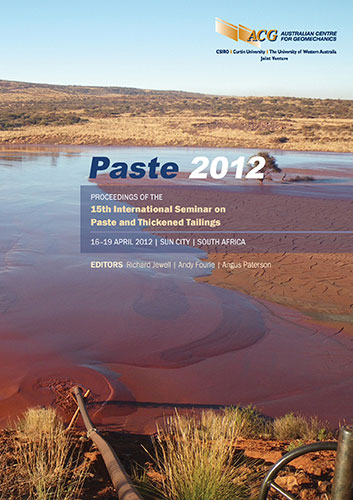Design and development of a novel thickener feedwell using computational fluid dynamics

|
Authors: Nguyen, TV; Farrow, JB; Smith, J; Fawell, PD Paper is not available for download Contact Us |
DOI https://doi.org/10.36487/ACG_rep/1263_10_Nguyen
Cite As:
Nguyen, TV, Farrow, JB, Smith, J & Fawell, PD 2012, 'Design and development of a novel thickener feedwell using computational fluid dynamics', in R Jewell, AB Fourie & A Paterson (eds), Paste 2012: Proceedings of the 15th International Seminar on Paste and Thickened Tailings, Australian Centre for Geomechanics, Perth, pp. 105-119, https://doi.org/10.36487/ACG_rep/1263_10_Nguyen
Abstract:
The feedwell performance in gravity thickeners and clarifiers relies on the efficient mixing between solid particles and flocculant to achieve effective flocculation, as well as energy dissipation of the incoming feed stream. A population balance-computational fluid dynamics (PB-CFD) model has been developed and validated to provide new insights into the operation and performance of industrial feedwells. In particular, the PB-CFD model enables the efficacy of the main functions of a feedwell to be investigated for a wide range of feedwell designs and process conditions. This paper describes how PB-CFD was used in the design and development of a new feedwell concept for the flocculation of particles in a solid-liquid stream. The patented feedwell design includes an upwardly converging flow diverter to create two separate compartments for energy dissipation and flocculation. PB-CFD simulations of this simple and easy-to-retrofit feedwell design illustrate a superior performance in terms of flocculation and energy dissipation compared to typical feedwells over a wide range of flow conditions. The potential benefits include reduced flocculant consumption, better de-aeration, greater stability and the ability to cope with a wider variation in volumetric throughput; better flocculation and fines capture, and a more symmetrical discharge may also offer improved overflow clarity in some applications. The new feedwell design has been installed in a full-scale thickener at an Anglo Platinum site in South Africa. A number of operational factors complicate this application, but indications are that the new feedwell has led to improvements in stability and underflow properties.
References:
Fawell, P.D., Farrow, J.B., Heath, A.R., Nguyen, T.V., Owen, A.T., Paterson, D., Rudman, M., Scales, P.J., Simic, K., Stephens,
D.W., Swift, J.D. and Usher, S.P. (2009) 20 years of AMIRA P266 'Improving Thickener Technology' – how has it changed the understanding of thickener performance?, in Proceedings 12th International Seminar on Paste and Thickened Tailings (Paste09), R.J. Jewell, A.B. Fourie, S. Barrera, J. Wiertz (eds), 21‒24 April 2009, Viña Del Mar, Chile, Gecamin Limited, Santiago, Australian Centre for Geomechanics, Perth, pp. 59–68.
Fawell, P.D., Simic, K., Mohanarangam, K., Stephens, D.W., Rudman, M., Paterson, D., Yang, W. and Farrow, J.B. (2011) Pilot and full-scale validation of thickener and feedwell modelling, in Proceedings 14th International Seminar on Paste and Thickened Tailings (Paste2011), R.J. Jewell and A.B. Fourie (eds), 5‒7 April 2011, Perth, Australia, Australian Centre for Geomechanics, Perth, pp. 81–91.
Johnston, R.R.M., Schwarz, P., Newman, M., Kershaw, M., Farrow, J.B., Simic, K. and Swift, J.D. (1998) Improving thickener performance at Pasminco Hobart Smelter, Zinc and Lead Processing, J.E. Dutrizac, J.A. Gonzalez, G.L. Bolton, P. Hancock (eds), Canadian Institute of Mining, Metallurgy and Petroleum, pp. 697–713.
Kahane, R.B., Nguyen, T.V. and Schwarz, M.P. (2002) CFD modelling of thickeners at Worsley Alumina Pty Ltd, Applied Mathematical Modelling, Vol. 26, No. 2, pp. 281–296.
Mohanarangam, K., Nguyen, T.V. and Stephens, D.W. (2009) Evaluation of two-equation turbulence models in a laboratory-scale thickener feedwell, Seventh International Conference on Computational Fluid Dynamics in the Minerals and Process Industries, 9–11 December, Melbourne.
Nguyen, T.V., Heath, A. and Witt, P. (2006) Population balance – CFD modelling of fluid flow, solids distribution and flocculation in thickener feedwells, in Proceedings Fifth International Conference on CFD in the Process Industries, Melbourne, Australia, December 2006.
© Copyright 2025, Australian Centre for Geomechanics (ACG), The University of Western Australia. All rights reserved.
View copyright/legal information
Please direct any queries or error reports to repository-acg@uwa.edu.au
View copyright/legal information
Please direct any queries or error reports to repository-acg@uwa.edu.au